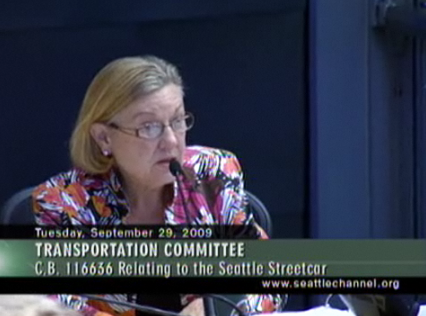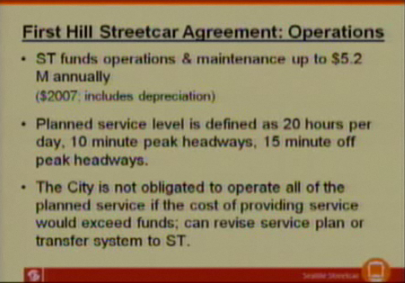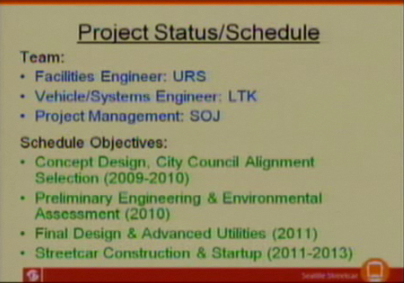 City Council transportation chair Jan Drago
City Council transportation chair Jan Drago
The First Hill-Capitol Hill streetcar is, yes, on track to begin service in late 2013 after the City Council transportation committee today passed a bill approving a memorandum of agreement between Sound Transit and the City of Seattle to pay for, plan and manage the streetcar line. The project is designed to connect Union Station to the Capitol Hill light rail station providing service to First Hill’s health-care workers and neighborhood residents when it is completed in 2016.
The bill approved by the committee today also puts the City Council in the streetcar driver’s seat calling for the government branch to define the line’s route and own the ongoing funding process to manage any costs overruns or renegotiation with Sound Transit. The agreement also calls for the Sound Transit Board to have approval as the design plans take shape.
Sound Transit is funding the city project in lieu of a First Hill-area station that could not be built as part of the light rail line. The bill approving the agreement now moves on to the full council. That vote may take place as soon as this Monday.
The agreement calls for Sound Transit to provide $120 million to fund construction of the line which the city will manage. Any construction overruns will be the responsibility of the city. Sound Transit will also provide $5.2 million annually for the city to operate the line starting in 2016. If the line starts running in 2013 as planned, the agreement calls for ST to annualize the funds it has set aside for operation over the longer period and pay out a smaller amount each year. City transportation planner Ethan Melone said that the city believes it can operate the line on the reduced budget and still meet Sound Transit’s service requirement.
We’ve included screengrabs of two of Melone’s slides from the committee meeting (sorry for the low quality). Melone described a process that begins with the City Council reviewing potential routes for everything from environmental, to community, to budgetary impacts over the next year with construction potentially beginning as early as 2011.
During the public comment period, Jim Erickson of the First Hill Improvement Association voiced his support for the plan. “Payback for this investment will begin on day one of its operation,” Erickson said. Kate Stineback of Capitol Hill Housing also spoke in support of the plan and the community process that will also shape the streetcar’s route. “The communities that I work in are very excited about a fully funded streetcar,” Stineback said, adding that she also wants data to drive analysis of the various possible routes for the line.
Councilmember Nick Licata dared utter the t-word asking if the agreement allowed for Sound Transit’s funding to be redirected to electric trolleys if the streetcar line proved unfeasible before construction. The short answer: no. Sound Transit’s Board has specifically approved funds for a streetcar line. To re-direct the funds would require their approval, per the streetcar agreement. Given that the ST Board has positioned the First Hill streetcar as a voter mandated project, such a change isn’t likely unless environmental or cost factors for the streetcar line are so bad that nothing can be built with the budgeted funds.
One interesting datapoint came up regarding the Boren route that has strong support from some on First Hill. Melone said that, of the potential routes, the steepest grade is on Boren but that the city believes streetcars could handle the slope. “”The steepest part of the alignment would be going up Boren,” Melone said. “We measured the grade and determined it is within the streetcar’s technical capabilities.”
In other words, a steep hill isn’t going to make it easier to arrive at an agreement on the line’s route.
For more on the likely routes for the streetcar, see Streetcar alternative route maps released and Putting more First Hill in the First Hill-Capitol Hill streetcar
Additional notes:
- The determination of the line’s route will include opportunity’s for community review and feedback that the Council will oversee.
- The $120 million for construction is planned to also cover a $10 to $14 million streetcar ‘barn’ facility. Location of the maintenance facility will also be part of alignment discussions.
- If construction bids come in above $120 million, the Council will on the spot to decide on how — and if — the city covers the budget gap.
- Per the agreement, Sound Transit keeps all farebox revenue from the line. They also have the right to sell advertising on the cars.
- When the transportation committee last discussed the streetcar this spring, there was discussion of the possibility of extending the route farther north. Low costs on the main route line could be applied to extending the route past the light rail station at John at Broadway. Sound Transit estimated that an extension from John to Aloha would cost about $26 million. We’ll have to follow up to see if this opportunity is still being considered.
- There was also a provision discussed in spring that construction of the streetcar cannot impede construction of the light rail system. This would likely mean the initial streetcar line would run only from Union Station to the Pike/Pine area until the majority of the light rail construction is completed.
- If the streetcar route from Union Station to Capitol Hill does end up with the accelerated schedule, it will be an island route until it can be connected to the route planned for downtown to connect with the service in South Lake Union.
- Trains will run every 10 minutes at peak, 20 minutes off-peak, 20 hours a day except on Sundays when they’ll run a reduced 12-hour schedule





Nick Licata has proven himself time and time again to be a reliable conservative voice on transit/urban issues. He is the most anti-transit council member we have seen in a long time. On the other hand, Jessie Israel is promising to push for more transit faster.
Joe Mallahan is the only one who could kill this thing, please vote McGinn if you weren’t planning on it already. He is opposed to all streetcars and the First Hill line in particular.
(I’m not affiliated with any campaign)
Nick Licata in 2005 supported Sound Transit’s very own reconsidered plans to eliminate the $350 million First Hill light rail subway station in favor of a $120 million streetcar that provides a shortcut to International District light rail station.
That’s Nick being both pro-transit and “conservative” with the taxpayers’ money, wanting to get the most value for the transit dollar.
Sound Transit easily found ways to spend the $230 million savings for other transit purposes.
Now asking about transit mode alternatives when the opportunity arises is also smart governance.
When did you move across the sound and onto the hill, John?
Glad to see a lot more detail in this post Justin. The last post seemed to argue that Capitol Hill is in some way trying to “take away” the First Hill Streetcar, which they are not! The group of estakeholders that have been articulating a need to study 12th Ave for an alignment are a very diverse group of folks from all three neighborhoods, First Hill, Central Area and Capitol Hill. This group continues to conduct extensive outreach, including trying to work with the FHIA on a LOOP alignment that would serve all three neighborhoods mentioned.
First Hill was promised a streetcar when they lost their Light Rail station years back (that is why the Light Rail will go from downtown to Cap Hill without a stop) Nobody disagrees with this. It is very important to keep the history in mind here. This streetcar is now FULLY FUNDED by last year’s ST ballot measure and it seems like the quicker we build it, perhaps the cheaper it will be given current bid climates.
The ordinance discussed today is a good one that we should all support, as it will deliver more transit options to our neighborhoods through a new streetcar funded by Sound Transit, no matter where the route goes. And, like I stated in public comment today, we are hoping for a robust public outreach process to begin soon that will study all three alignments currently on the table in terms of ridership, cost, economic development, travel times and environmental justice, hopefully to name just a few.
To be fair, the previous post you refer to was not intended to be a complete overview of the streetcar’s status. Just wanted to get some more First Hill voice into the conversation.
More importantly, wow, am I sorry for butchering your name! I blame the computer!
it is ok, even CHH misspells my name quite frequently. thanks for clarifying justin. it is always dangerous to amplify a voice without context though…i am sensitive to it seeming like Cap Hill doesn’t recognize that the whole reason this streetcar exists is because the First Hill Light Rail Station went away. people get this, but they also get that that station was to be at boylston and madison, likely with an entrance on or near broadway, which is literally the convergence of three urban villages – pike-pine, first hill and 12th avenue (part of the central area).
To clarify, the First Hill Station was to have two entrances. One entrance at Boylston and Madison, to serve Seattle U and Seattle Central; the other one at Minor and Madison, on the site of the former US Bank, to serve Swedish, Virginia Mason and Harborview.
Further study will need to be done, but preliminary analysis done by Sound Transit suggests a loop route will not provide the improvement in travel times called out for in the project. In fact, it would be faster for someone working at Virginia Mason or Swedish to walk to the Capitol Hill station than to ride the streetcar to it, assuming it travels 12th Avenue/Broadway in a counter-clockwise loop. That is why the First Hill community organizations want the streetcar to run north on Boren to Madison or Seneca, then head east to Broadway.
The Memorandum of Agreement that the Transportation Committee approved today also specifies that the streetcar be a dual-track line, This would seem to preclude a loop option.
good clarifications, but I wonder, will a streetcar stuck in traffic on boren be any faster for a VM employee than one on broadway or a LOOP on broadway-12th? won’t taking the bus from the 3rd and University station (or walking) always be faster than any streetcar route for a VM employee? i really hope there is an analysis of these alternatives, because people are making a lot of assumptions about why cities build streetcars and how they serve people…they aren’t just for transit (they move with traffic), they are for economic development! all you have to do is look at what portland has done with their lines.
The fact that John Niles, also one of the people who tried to kill Link light rail for years, is speaking up for Nick Licata speaks volumes.
Go Jessie.
First Hill has all the aces, that simple.
I understand the streetcar needs to address the incredibly short sighted omission of First Hill (and before this conversation takes a turn, I understand the “why”, but that still doesn’t make it the right decision, especially in the long term), but do you really think that the primary metric for determining where the streetcar runs should be commuter concerns?
Streetcars as a means of transit are not about point-to-point connectivity (i.e. commute times). That is what light rail is supposed to do. Streetcars are about high-capacity connectivity to multiple points along the length of the route. They run in traffic, and hopefully alleviate congestion, but unless they have an exclusive ROW they are prone to the same traffic woes as cars and buses, and are therefore no more reliable from a timing perspective. Their primary benefits are related to capacity (i.e high ridership), lower long-term maintenance costs and as an indicator of long-term investment.
Should the routing of the First Hill Streetcar really be just about commuters and ensuring theoretical minimum commute times an d front door service? What about the residents who live in the neighborhoods, the ones who spend 24 hours a day there?
One last point, before I run off to work because this is an item that is being overlooked in the arguments against the loop… the First Hill Streetcar connects First Hill to the light rail stations in both Capitol Hill and the ID. So, assuming the streetcar runs through a loop in a counter-clockwise manner, a commuter from VM could ride the streetcar from the Capitol Hill station to VM in the morning. In the evening they would not have to ride the streetcar through the length of the loop to get back to Capitol Hill, but instead simply continue their ride south into the ID and catch the light rail from there headed north. Yes, this adds 10 minutes to the length of their commute on light rail, but I feel this is a small inconvenience for commuters when compared to the potential benefits to the residents of the neighborhoods the loop route would serve. Plus hopping onto light rail at the ID would almost guarantee a seat on the ride home!